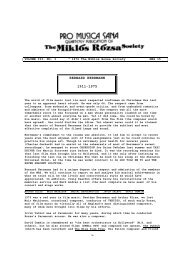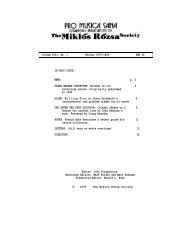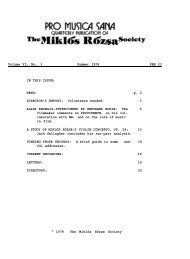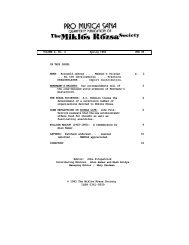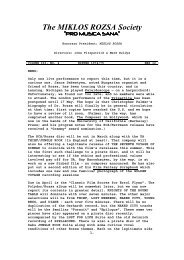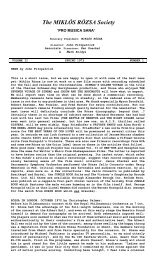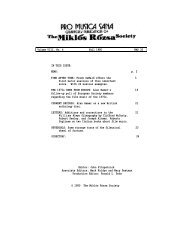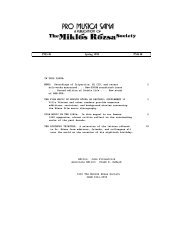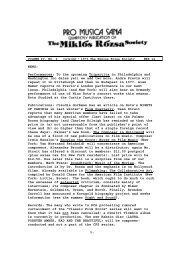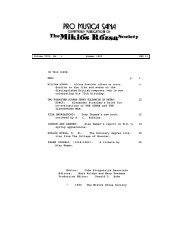Volume IV, No. 4 ©1976 The Miklos Rozsa Society MRS 16 1
Volume IV, No. 4 ©1976 The Miklos Rozsa Society MRS 16 1
Volume IV, No. 4 ©1976 The Miklos Rozsa Society MRS 16 1
Create successful ePaper yourself
Turn your PDF publications into a flip-book with our unique Google optimized e-Paper software.
Finally, Bertrand Borie reports that L’Association <strong>Miklos</strong> <strong>Rozsa</strong>-France isofficially established. Contact him at 44 Quai Carnot, 92210 St.-Cloud,France.Errata:<strong>MRS</strong> 15 was bedeviled with more than its share of editorial blunders, forwhich we apologize to all concerned. to start with, it belongs to <strong>Volume</strong><strong>IV</strong>, not III. Collectors of back issues should be reminded in thisconnection that <strong>MRS</strong> 7 should be labeled <strong>Volume</strong> II, <strong>No</strong>. 3.On page 2, line 12, read “smile” instead of “smirk”.On page 3, last paragraph, line 5, read “Herrmann’s” instead of“Corwin’s”.On page 4, line 5, read “overestimated” instead of “underestimated”.Finally, although Mark Andres’s list of the concert and stage works ofBarnard Herrmann remains the most complete we have seen, Craig Reardonand others have pointed out some errors and omissions. Omitted were the1942 concert suite from THE DEVIL AND DANIEL WEBSTER, the late-60s(unsuccessful) musical comedy 4aa the Schnorrers (with Diane Lampert),end the 1967 Clarinet Quintet. Echoes was composed in 1965—66, not 1943.And, of course, no attempt was made to cover Herrmann’s extensive radioand television work, even though the latter included two operas, AChristmas Carol and A Child is Born, in the mid-5Os.BOOKS by John Fitzpatrick:Roger Manvell and John Huntley, <strong>The</strong> Technique of Film MusicSecond edition revised and enlarged by Richard Arnell and Peter DayLondon: Focal Press, 1975New York, Hastings House, 1975 ($18.50)Rome: Edizioni di Bisnco e Nero (Italian edition not seen)Three years have passed since I described this book as “essential” andmuch has happened in film music to suggest the. need for a revaluation.Aside from the new journals and the new awareness in the establishedpublications, we have also had Tony Thomas’s familiar but usefulbiographical sketches of some Hollywood composers in Music for theMovies. Thomas’s volume had few pretensions toward musical or cinematicanalysis, but more recently Mark Evans (Soundtrack: <strong>The</strong> Music of theMovies) and Irwin Bazelon (Knowing the Score) have moved in thatdirection. About both of these I am in general agreement with mycolleagues (see <strong>MRS</strong> 15): Evans weakened his genuine insights by trying tocover too much, the result being a different kind of thinness. AndBazelon, while often providing more acute musical thought in a singlepage than the others did in an entire chapter, also let his barelydisguised prejudice in favor of a particular school, “the contemporaryAmerican concert composer,” lead him into some grotesque historicaldistortions and critical nonsense. So, while I can recommend any of theabove works for different purposes, Manvell and Huntley remains thecentral volume for everyone - even though the new edition has someproblems and the 50% price increase has been accompanied by the additionof only a few pages to the total length.In a sense the revisers, composer Riobard Arnell and film maker PeterDay, were unlucky in their timing. <strong>The</strong>ir new edition bears the date 1975but has a cutoff point for critical and bibltgraphical material at theend of 1972, i.e., before the onset of the current film musicrenaissance. As a result, they inevitably faced some problems ofhistorical perspective. A consideration of the original volume will helpto explain these.4.
Technique first appeared in 1957 (cut—off, end of 1955). It offered twogood chapters on the history of the art to 1935 and then a massivecritical and technical discussion of the ways in which music functionedin many outstanding scores of the decades 1935—55. <strong>The</strong>re followed a lookat sound studio technique, a large selection of composers’ viewpoints,and four solid appendices: an outline—history of film music by year(mostly a list of important scores and awards), a huge discography, apair of model essays in film music critician (too infrequently imitatedsince), and the best bibliography ever compiled on the subject. <strong>The</strong>authors received everywhere the guidance of an able British Film Academycommittee that included Muir Mathieson and William Alwyn. <strong>The</strong>se in turnsought and received comments from many of the leading composers of theday, so that the volume was full of observations by <strong>Rozsa</strong>, Herrmann,Vaughan Williams, Friedhofer, Raksin, and many others.<strong>The</strong> new version revises very little and omits almost nothing. yet wherematerial such as that concerning recording techniques is declaredobsolete it is qualified only by additional paragraphs at the end of thechapter. <strong>The</strong> only substantial cut is the 55—page discography. This isunderstandable. <strong>The</strong> old list was mostly concerned with 78s and theearliest LPs and could have only (considerable) historical value today; anew one on the same scale would plainly have been impossible. This spaceand more (the book has been expanded to 310 pages) is taken up not onlyby an extension of the other-r appendices but also by many new sectionson filmed lives of composers, new techniques in electronics andanimation, further composers’ and – strikingly – film makers’ view, and achapter on what are supposed to be four key scores since 1955.It is this last that best illustrates where the revisers went wrong. <strong>The</strong>yrightly point out in an introduction that pop, electronic, classicalborrowing,and even non—musical trends have become dominant in recentyears and they understandably feel that this fact should be met withserious discussion rather than the hysteria popular in some quarters. Yetthere is not really very much to say about 2001, and on ZABRlSKIE POINTthe comments seem curiously unconcerned with the final musical anddramatic value of the pop songs chosen by Antonioni (who has earlier inthe volume indicated his basic lack of sympathy for real musicalexpression in films). Good points are made about Peter Maxell Davies’sTHE DEVILS and about SECOND BEST, but the latter (scored by Arnell) isobviously too little known for illustrative purposes.Thus, with examples from only the last four years of the period, do Smelland Day attempt to characterize seventeen years of film music. It is easyto see what must have happened. Eager to pinpoint the most recent trends,the revisers lost their sense of perspective and let those trendsstrangle them. <strong>The</strong> years 1988—1972 struck them as the beginning of an erawhereas they now seem more like an unfortunate transitional period. It issignificant in this connection that the Technique, alone of the fourvolumes I have mentioned, never once uses the term, “Golden Age of FilmMusic.” I have never really understood this peculiar concept. If it ismeant to imply that the Hollywood, or any other, system regularly turnedout an invariable succession of musico—dramatic masterpieces, then Iseriously question the sanity of anyone who believes in it. But if itmeans only those years when some composers of recognised ability producedtheir best and most mature works (and usually got them recorded), then Iwould submit that the real “Golden Age” occurred not as is usuallyimagined in the 30s and 40s, but rather precisely during the first decadeof Arnell and Day’s seventeen year period, 1956-66. What really happened,5.
I believe, is that the traditional film score crested during those yearsand declined in the late 60s only to rise again after 1972. Only timewill tell about this last point, and the revisers, at any rate, cannot beblamed for failing to predict it. But about the first there can be littledispute. Just consider the key works of these years for only a fewHollywood—based composers: <strong>Rozsa</strong>: LUST FOR LIFE, BEN—HUR, EL CID; Newman:THE DIARY OF ANNE FRANK, HOW THE WEST WAS WON, THE GREATEST STORY EVERTOLD; Herrmann: TEE SEVENTH VOYAGE OF SINBAD, PSYCHO, VERTIGO, FAHRENHEIT451; Waxman: PEYTON PLACE, THE NUN’S STORY, THE STORY OF RUTH, TARASBULBA, and so on. Even younger composers like Bernstein and <strong>No</strong>rth mayhave done their best work during these years: SPARTACUS, CLEOPATRA,DESIRE UNDER THE ELMS, THE MAGNIFICENT SEVEN, TO KILL A MOCKINGBIRD,HAWAII, etc. Individual cases may be argued but surely not the entiretrend. Yet not one of these scores discussed in the new edition. Insteadthere is the absurd generalization that the “symphonic” approach has beenpreserved in Shostakovich’s scores for Kozintsey (p. 245): By the mostrestrictive definition of “symphonic” this is still nonsense; even theearly 70s, after all, brought us the maturity of Goldsmith, PATTON andPAPILLON; THE PR<strong>IV</strong>ATE LIFE OF SHERLOCK HOLMES; and LADY CAROLINE LAMB.This same sort of imbalance pervades the extended appendices, whereBANNING, JIGSAW, THE FROGS, and ESCAPE FROM THE PLANET OF THE APES arementioned but not most of the scores cited above. I do not quarrel with,indeed I welcome, the international character of the list here. <strong>No</strong>r do Iobject to the need to recognize historically influential landmarks likeBREAKFAST AT TIFFANY’S, THUNDEHBALL, BUTCH CASSIDY AND THE SUNDANCE KID,or A HARD DAY’S NIGHT. But I do feel something is terribly wrong with thefocus of the revision. <strong>The</strong> very composers cited as masters in theoriginal text are here dismissed both as authorities and as examples.History need not be displayed in a book on technique, but a sense ofhistory is essential to its writing. Arnell and Day are defective in thissense.Perhaps the bibliography offers an explanation. <strong>The</strong>re are some shockingomissions, e.g., the composer biographies in Films in Review which,whatever their musical merits, were the most complete available in 1972.(Mention is made of Page Cook’s “Sound Track” column but nothing is madeof it or of the “Records” column in Films and Filming). Yet the revisersdo manage to come up with much valuable material from other even lesslikely sources - everything from <strong>The</strong> American Cinematographer to Bianco eNero. That, after all, is what a bibliography is for, and this one, forall its faults, is the best in print. And so is the book. <strong>The</strong> reader whocan keep matters in perspective will find a superb work imperfectlyextended. Perhaps one such reader will have the perspective needed toprepare the third edition in 1993.PROKOFIEV’S SCORE FOR <strong>IV</strong>AN THE TERRIBLE by Mary Peatman:<strong>IV</strong>AN THE TERRIBLE is surprisingly neglected in this country. It hassuffered particularly from being discussed in the context of Eisenstein’sother films, of which THE BATTLESHIP POPEMKIN and ALEXANDER NEVSKY tendto capture stage center (although there are exceptions which may beheralding a change: Yon Baroa [Eisenstein] and Peter Harcourt in hisrecent book, Six European Directors, have done such to redress thissituation). Such is perhaps even more the case with <strong>IV</strong>AN’s score. Howoften has6.
Prokofiev’s contribution to film been praised - and yet how few peoplereally know the music for <strong>IV</strong>AN. It is ALEXANDER NEVSKY whose score isknown, thanks to frequent and successful performances and severalrecordings of the cantata. For various reasons, some - of them justified,the <strong>IV</strong>AN Oratorio hasn’t received this kind of attention. Unfortunatelyfor <strong>IV</strong>AN, concert ball fame seems to be a necessary prerequisite for thepublic success of a Prokofiev film score: one of his most famous concertpieces, in fact, is from a film still virtually unown in this country,LT. KIJE (although according to Jay Leyda in his Kino: A History of theRussian and Soviet Films, this score made a second appearance in THEHORSE’S MOUTH, a British film directed by Ronald Neame and released in1958).<strong>The</strong> essay that follows is an attempt to redress the balance. My ownfeeling is that in many ways the score for <strong>IV</strong>AN is superior to itspredecessor, ALEXANDER NEVSKY; among other things, it strikes me as moreclosely integrated with the drama and its visualization. (I am not alonein my opinion; Bernard Herrmann stated more than once that he felt <strong>IV</strong>AN’sscore was the greatest ever written for any film.) To present the music’sfunction to readers who might be unfamiliar with the film poses problemsto which I have tried to respond in the essay. For anyone of a moreambitious bent, however, Simon and Schuster published the script (cuttingcontinuity) in their Classic Film Script series in 1970, a paperback thatis still in print. My short references are keyed to that text. Also,there is a recording of the Oratorio, about which more later.To compose for historical or costume epics is to face special problemsabove and beyond those confronting musicians who score films withcontemporary settings, Both William Walton (concerning HENRY V) and<strong>Miklos</strong> <strong>Rozsa</strong> attest to the need to take into account historicalauthenticity while at the same time avoiding stilted archaisms. <strong>Rozsa</strong>formulated the problem as follow:[<strong>The</strong> music] has to be stylised, as the very nature of dramaticmusic excludes, the verbatim usage of music of periods:... With themelodic, rhythmic, and harmonic elements of the past, [however,]the modern composer can create a dramatic language of his own,which fits the style of the screen—drama.1Both ALEXANDER NEVSKY and <strong>IV</strong>AN THE TERRIBLE posed problems of this sortfor Serge Prokofiev. In tackling them, he put special emphasis on twopoints: the tine period and national differences. In NEVSKY the musicportraying the Teutonic Knights stands in contrast with that of theRussians; and while <strong>IV</strong>AN is full of old Russian themes, folksongs, andmusic for other rituals, the Tartars and Poles have a differentsort of music. Like Walton (in HENRY V again), Prokofiev alternatesbetween more obvious archaisms (melodies that are easily recognized asstemming from an ancient, nationalistic tradition) and materials of hisown invention which are tailored to “fit the mood” <strong>The</strong> former categoryincludes such items as the song “Have Mercy O Lord,” which is sung by thepeople when they come to Alezandrovakaya Sloboda to call Ivan back toMoscow at the end of Part I (people familiar with the Russian Orthodoxservice or Tchaikovsky’s 1812 Overture will recognize the melody). <strong>The</strong>most obvious instance of the latter group is, perhaps, the musicaccompanying the death of Vladimir in Part II.Before the music of the film is considered, some attention should begiven to Prokofiev’s background with respect to film music - that of <strong>IV</strong>ANin particular.7.
It seems that the composer had at least a hand in film projects datingback as early as 1933 (the year of his return from abroad and usuallyconsidered the advent of his “Soviet” period), the first being LT. KIJE,directed by A. Feinzimmer. Apart from NEVSKY and <strong>IV</strong>AN, this is the filmfor which Prokofiev is best remembered, primarily because of the suite hefashioned from that score. His other major films are as follows: QUEEN OFSPADES (1936) (not an adaption of Tchaikovsky, but an original score fora screen adaptation of Pushkin’s play), PARTISANS IN THE UKRANIAN STEPPE(1942), KOTOVSKY (1942), LERMONTOV (1942), and TONIA (1942).2 Needless tosay, most of these films (including LT. KIJE) are not familiar outsidethe Soviet Union. However, the point to be emphasized here is thatProkofiev did have experience in this area prior to his association withEisenstein. Also noteworthy is that Eisenstein approached the composershortly after the completion of NEVSKY in hopes of getting him to work onhis film FERGHANA CANAL.3 That Prokofiev, who was in the midst ofcomposing the opera Semyon Kotko at the time,4 was unable to consent andsent Eisenstein his regrets in a letter dated 30 July l939.5 As it turnedout, the project never materialized, proving to be another ofEisenstein’s “unfinished symphonies.”It is to Prokofiev’s credit that he took film composing seriously; itwasn’t something to be done on the side while waiting for somethingbetter to come his way.With his characteristic directness, he asserted the rights of thecomposer in the cinema, sharply criticizing the “anti—musical”tendencies of culturally underdeveloped directors...“I still consider the motion picture the most modern art,” hemaintained in a letter [to Eisenstein].6And Eisenstein is to be commended, too, for realizing that he and hisfilms would benefit considerably if he worked with Prokofiev from theoutset, rather than calling him in after the material was shot. We findthe following letter from Eisenstein to Prokofiev, dated December 1941,reading:I am writing hurriedly... Facts: TERRIBLE is to be shot....Currently I am completing the scenario and will send it to you onthe next occasion. At the beginning of next year, it will alreadybe possible to come to agreements - to get together, etc.It has two parts - entertaining at the highest level.Comrade Composer is offered great freedom in any direction.7<strong>The</strong>ir actual method of work has bean described in depth by Eisensteinhimself; his essay entitled “P—R—K—F—V” is anthologized in <strong>No</strong>tes of aFilm Director (New York: Dover Publications, 197O).<strong>The</strong> discussion that follows does not aim to be all—inclusive, but ratherto present the various approaches that Prokofiev employed in puttingmusical expression into filmic material. For his was not an exclusivemethod. He combined the use of the “leitmotif” with that of the tonepainting; he also composed a vast amount of on-screen (“actual” orfunctional) material, some of it strikingly operatic in quality.Before we enter into this discussion, however, a brief plot sketch mightbe in order. <strong>The</strong> film as we have it (it is incomplete) is in two parts.Part I represents Ivan’s coronation as the first Tsar of Russia in theface of much opposition from the Church and the boyars (nobles), hismarriage, his conquest of the outlying territory of Kazan, his illnessand consequent anxiety about his infsnt son’s succession, the illness andsubsequent poisoning of his wife by the leader of the boyar opposition8.
(Ivan’s mannish aunt, Efrosyniya Staritsky), and Ivan’s ultimatedecision, in the face of treachery, to form a private bodyguard, theOprichnina. Part II represents the continuing internal problems of Ivan’srule: the Tsar recalls a former friend—turned—monk, Philip Kelychev, fromhis monastery only to discover in him a new enemy, and he learns thatEfrosyniya, in addition to having poisoned his wife, has hopes ofinstalling her own backward son, Vladimir, on the throne. But Ivanretaliates: at a sumptuous banquet he plies Vladimir with liquor, coaxesout of him a confession of the plot and, dressing him up in the Tsar’sregalia, sends him to the cathedral and the knife intended for the Tsar,<strong>The</strong> richest category in terms of expressive development of the music for<strong>IV</strong>AN is that of the “tone paintings.” Prokofiev’s opportunities in thisarea were unusual in that he was able to compose large stretches ofuninterrupted music - music that conveys moods that are visuallysuppressed. This is perhaps the most difficult test of the sensitivity,function, and effectiveness of music in any film; Prokofiev more thanrose to the occasion.<strong>The</strong> major sequences so accompanied include the Moscow uprising, its musicstanding in violent contrast to the gay, festive melodies of the weddingscene that precedes it; the approach to and attack on Kazan (thisinvolves the development of several pieces of material); Ivan’s plea thatthe boyars honor his son; Anastasia’s illness (the musical compositionembraces two overlapping scenes); a scene set at the court of KingSigismund of Poland; and Vladimir’s death. In most cases the themes donot function as leitmotifs; rather, they are relegated to the oneinstance and developed, more or less, within that situation only.<strong>The</strong> music accompanying Anastasia’s and Ivan’s last moments togetherprovides a good working case. Seated in the throne room, Ivan holdsattendance on the boyars and the ambassador to England. With the boyarshe shows a loss of patience and strong inner turmoil, finally losing histemper altogether. He seems to regain it again in part when he meets withthe ambassador: he acts to all appearances as though strategy games arehis cure. But when the ambassador also departs, leaving Ivan to himself,a second mask seems to fall as well: he suddenly seems wisened, old, andterribly alone. It is at this point that the music takes over the role of“projecting” this sense of Ivan’s suffering and threatened loss.Up to now we have been given no clue about Anastasia’s sickness, but themusic prepares us in advance for the upcoming scene by setting its moodat the same time it conveys Ivan’s own shift in thought and tempo. <strong>The</strong>music is tuneful, gentle, and delicate, but it also bears a suggestion ofmournfulness, conveyed by the minor key, the slow, almost funereal, pace,and the legato line. <strong>The</strong> melody suggests much tenderness (Ivan is veryclose to and dependent on his wife) and the instrumentation - stringsalone - contributes to this quality as well am to the sense of fusion.(a).This theme has a counterpart, the basic quality of which is moreagitated, even though it is an intrinsic part of this music as a whole(b). <strong>The</strong> tempo tends to pick up and the instrumentation is different: thenew melody (b) is carried by an oboe. Given sufficient intensity(including an increase in volume), it hints at trouble, and troubleindeed comes - in the form of the arriving messenger, who runs in to thetune of this variant.9.
Such is Prokofiev’s basic material in this episode; by means of it hecarries us through the one scene and into the transition and preparationfor the next. <strong>The</strong> passage begins right after the ambassador’s departure.With it, we feel, has gone all of Ivan’s presence as Tsar; what we seenow is only the human figure, very much dwarfed by the great size of thehall. He draws his cloak closer about him and sits back - weary?Troubled? <strong>The</strong> melancholy nature of the music certainly suggests this.<strong>The</strong> next series of shots orients us. We are taken, rather briefly, toAnastasia’s room – bed - and to her face in closeup, showing her stirringin troubled sleep with Efrosyniya, shrouded in black, hovering over herlike a bird of prey. <strong>The</strong> music has continued steadily throughout, itsonly change being one of volume as it swells and recedes once again.It continues as we return to Ivan in the throne room, still in anattitude, of exhaustion. Helplessness is further suggested in the mannerof his departure from the room a minute later. By the time we havereturned (with Ivan, this tine) to Anastasia’s chambers again, we knowthe music has fulfilled its initial function as a foreshadowing device(we realize, what is bothering the Tsar); now it takes over the role of amood gauge until the messenger arrives. Here again, though, the musictells us even before Ivan reads the letter that evil tidings have come.<strong>The</strong> potential of the (b) theme is brought to fruition by a suddenincrease in tempo and volume, carrying a heightened sense of agitationwhich easily translates into disaster. <strong>The</strong> sound of running steps,followed by the sight of the messenger (bringing news of boyar treachery)dashing up the stain, reinforces this sharp shift in mood.At times throughout this long musical passage we are acutely aware of itseffect on us as it alters the pacing; at others, it reinforces the moodalready dominant in the scene. Such is the case during most of Ivan’sconversation with Anastasia, although here, too, there is added emotionaldepth. <strong>The</strong> exchange between the two is one of the few tender moments inthe entire film, and the music does not let us forget it.Three other sequences are outstanding for the extended musical treatmentthey entail: Ivan’s plea to the boyars, the scene at the Polish court,and the death of Vladimir Staritsky. Of two - Ivan’s plea and Vladimir’sdeath - something should be said here.Pacing is vital in both, and this is governed in great part by the music.In the case of Ivan’s illness, the two dominant visual rhythms arecarried by Ivan’s intense but futile efforts on the one hand (he is, ofcourse, very weak) and the sluggish movements of the heavily overdressedboyars on the other. <strong>The</strong> music, speaking for Ivan’s pain and impotence,ebbs and flows as his actions reach passionate intensity and then ceasein exhaustion. This pattern occurs twice, but the second climax,involving a change of attitude in Ivan, carries with it a dramatic shiftin tone. Seeing himself betrayed, he whispers a curse, low and burningwith anger, at which point the music shifts from the pathetic portrait ofthe “plea” to a series of heavy menacing chords quite appropriate for aconsignment to the nether world (c).<strong>The</strong> murder of Vladimir in Part II is highly ritualized and unreal -nightmarish in the true German Expressionist tradition. <strong>The</strong> procession tothe cathedral which precedes Vladimir’s death is quite long anduninterrupted; suspense is built gradually but with irresistible pressurethrough a steady increase in the volume of the eerie music which includesthe humming of the (offstage) chorus which becomes11.
open—mouthed until, an instant before the stabbing, the music ceasesaltogether on the conclusion of a climactic phrase. <strong>The</strong> killing isperformed in a terrifying split-second sequence broken only by Vladimir’sdeath cry - a short, pathetically high-pitched “ah!” This is followed bya plunging violin scale, repeated once and lasting only a few seconds;then silace, musically, as Efrosyniya rushes forward to proclaim -mistakenly, of course - Ivan’s death.Here again we are dealing with an uninterrupted musical “composition” ofsome length which governs much of the tempo and mood of the scene.Curiously enough, the effect is in a certain sense one of a silentpicture with an orchestral accompaniment added, and for two good reasons:no other sound to speak of is heard on the track, and a significant partof the sequence is in long shot. As a result one is extremely consciousof the overwhelming richness of the texture of the music, and it becomesincreasingly “present” in the awareness of the viewer as the tensionbuilds. We see all the plotted moves in a way that conveys a sense ofomnipresence; three high angle long shots are of particular importance inthis respect, especially the one of the murder itself. Consequently, wefind ourselves mentally ahead of those ‘beneath” us and almost directingthe next inevitable move - but the invisible yet seemingly omnipresentIvan guides our minds in turn. And all the while we are enveloped in theresounding chorus - ”heavenly” in the sense of being invisible andomnipresent but hellish in its horrific quality - which pressures us onto the destined end.This supernatural effect of the chorus is further aided by anotherfactor. Because of a set of previous associations (the chorus and thedance staged earlier), we think momentarily in this scene that thehumming is coming from the Oprichniks (Ivan’s bodyguards) themselves, whoare the on—screen emissaries of death (Peter Volynets, the actual killer,is a mere tool). Yet these figures are so impersonalized, so cold, as tobecome detached from the singing. (Usually their faces are not seen, andwhen they are, they are quite stony; one never thinks of “chorus” in thehuman sense.) On the other hand, the music itself is immediate; it is notgoverned by the sound laws of the cathedral, whose acoustics we areacquainted with through previous exposure in the film. <strong>The</strong> result isdisconcerting.In all three cases considered the music involves very little basicmaterial: its effectiveness depends mostly on what is done with it. <strong>The</strong>regulation of the dynamics, the coordination of the musical phrase withthe rhythm of the action, the split—second timing of a climax: all serveto work on the spectator. Sometimes we are aware of it, sometimes not.<strong>The</strong> rest of the secret lies, of course, in the rightness of the themesthemselves: their worth both as music per se and as music for aparticular occasion.A great deal of the music in the film is written as “actual music” - thatis to say, music performed within the visual confines of the set itself(a choir heard but not seen within the cathedral would still be a case inpoint). Much of the sense of “opera” comes through the presences ofseveral “set” pieces of this sort, some of which are treated in a mannerbordering on the Italian (not Wagnerian!) operatic tradition. Such, forinstance, is Efrosyniya’s “lullaby” to her son, Feodor’s song and theOprichnik chorus that punctuates it and the song of the three innocentsin the Chaldean playlet sequence.12.
Even so, these are not operatic numbers per se. One of the most importanttensions built into the film’s structure is that between the stage andfilmic elements, and the music reinforces this ambience. Efrosyniya’ssong has a claim both to realism (mothers do sing lullabies to theirchildren) and to borderline histrionics (this is not what one wouldexpect a mother to do given this situation; nor, literally speaking, isVladimir a child). Tavern choruses are also conon enough in reality; thatthe Tsar’s men should sing a rousing song and dance to it is not initself so strange. <strong>The</strong> context, however - the threat of murder and thescheming that is developing on both sides - strikes one as anything butapropos and so casts an air of nightmare.As for the scene of the Russian-style “mousetrap” (the Chaldean playletsequence), the entire episode involves the p1ay—within—the-play; thechorus of the three “innocents” is thus thoroughly ensconced in atheatrical situation. (<strong>The</strong> monk, Philip, has arranged to have the storyof Nebuchadnezzar’s attempted burning of the “three innocents” [Daniel3:12-30] acted out before Ivan in the cathedral in the hope that the Tsarwill recognise himself as the “terrible pagan king” and desist in his“outrageous” behavior. But Ivan reacts differently than is anticipated:angered, he declares that “I will be what you call me—I will beterrible.” This is the only time in the film proper his appellation ismentioned.) One must look elsewhere to reach the more realistic element,namely the motivation behind the instigation of the playlet and thecountermotives aimed against it. And even at this level the whole thingis still a game of sorts, even though the moves are in deadly earnest.<strong>The</strong> music in these cases heightens the operatic elements, but equallyimportant is the manner of its execution. In the Chaldean playlet thethree “angelic cherubs” are in fact inexperienced boy sopranos, nervousfor fear of mistakes (they haven’t had much rehearsal time, after all)and perhaps also afraid of the reaction of the “terrible Tsar - one isquick to notice their forced notes, which are a little too loud, andtheir exaggerated efforts to keep together. <strong>The</strong>ir execution is quiteseamy of course (we are perhaps reminded of our own experiences withamateur youth performance), but it has its affect on us - and on Ivan -for precisely this reason. Set against this piping treble are thebooming, sneering voices of the two Chaldeans, always heralded by thecymbal crash; finally, Ivan’s demonic laugh, echoing ominously throughthe cathedral, cuts through all.<strong>The</strong> case of Efrosyniya’s lullaby is different, but beneath thedifferences the effect is remarkably similar. In this instance, true, wehave no intervening boundaries of “play” with which to set the episodeapart. But the reality is undercut, even so, both by her lyrics (“did shemake them up?”) and by the effect they have on Vladimir (they areanything but soothing). Indeed, the question of realistic expectationbreaks down altogether at this point. But then why have a lullaby at all?To what purpose?<strong>The</strong> purpose is ironic. That the “lullaby” is anything but comforting isexactly the point, both what Efrosyniya sings and how she sings it makethis clear.9 <strong>The</strong> lyrics are rousing, not quieting - stimulating andexhilarating to her, hideous to the point of being unendurable to him.<strong>The</strong> sequence underlies again and again the basic differences betweenmother and son: she shows increasingly glee, almost bloodthirstiness, asshe warms up to the rhythm of the song; while Vladimir ends up breakingaway from his position of cuddled security and, darting the swift glances13.
of a pursued animal, runs out of the “sanctuary.” As he becomes morechild, Efrosyniya become’s less mother, transported as she is from anysemblance of tenderness by the idea of using Vladimir as a tool for herown material ends.<strong>The</strong> manner of the delivery of the song is the other half of this scene’seffectiveness. While physical movement is pretty much confined to kneebouncingand glittering eyes (she maintains, ironically enough, a“mothering” attitude throughout), the voice is most expressive.10 <strong>The</strong>rendition comes nowhere near an operatic performance, but the tune iscarried with spirit and vigor. <strong>The</strong> very roughness helps conveyEfrosyniya’s own characteristics: she is quite indelicate here, and shebecomes more so as she describes her son’s own ascension to the throne.<strong>The</strong> song conveys perhaps batter than any words her basic desires.One of the most startling aspects of this episode is the sudden andtotally unnaturalistic entrance of a strong, robust chorus in support ofher final phrase, <strong>The</strong>re is no way one can really link this chorus withany other in the film, but a possibility that bears some weight bothplotwise and in terms of certain tonal resemblances is to link it withthe Oprichnik chorus itself as it functions throughout the film. (Fromall I can tell from the consistently poor sound tracks I have heard, bothchoruses are all—male.) In this case the chorus is invisible - indeed,untraceable for us as for Efrosyniya. Whether or not she actually hearsit is again an irrelevant because naturalistic issue. Its function istwofold, first, as an externalization of her wish—dream; and second –ironically - as a foreshadowing for us of the disaster that is to befallher in the death of her son. <strong>The</strong> implication behind the visual—aurallinkage of these two moments is that Efrosyniya is blind to the dangerboth times; only after it is too late does she waken to the irony.<strong>The</strong> lullaby has its aftermath in Vladimir’s death scene as well,Prokofiew is superb in conveying irony or dramatic reversal in musicalterms (a case in point will be considered in depth shortly), and a fineexample is heard after the murder. At this point, having discovered thatit is in truth her son and not Ivan who has been killed, Efrosyniyabegins again to sing the song (and again she casts an image of motherhoodas she holds the dead body of Vladimir in her arms), but now her voicehas lost luster. Broken with shock, she finally gives out altogether whenher son is taken from her.<strong>The</strong> case of Faodor’s song and the Orpichniks’ chorus is traditionalenough to be grasped easily in terms of its function in the film.However, Prokofiev employs the material established by the song for anironic and satirical purpose that is worth attention. Furthermore, thisalso involves the use of what could rightfully be called a leitmotif.When a given fragment of music occurs in various dramatic situations, itconveys to us information that we might not (often should not) graspotherwise by linking elements in incident “two” with parallel elements inincident “one. In so far as it is transformed, the music also conveysadditional information, too. This is the strict function of a motif.Before considering the example mentioned above, it should be pointed outthat while Ivan himself has a “theme” which is heard frequentlythroughout the film, it doesn’t usually function as a motif.14.
This music both opens and closes the film and is used extensively in theinterim, but while it even undergoes variations on occasion, it usuallyfails to function even in these cases in a dramatically informative way;if anything, it tends merely to underscore the obvious. While the musicper se is appropriate and effective, Prokofiev’a use of it often fallsshort of its potential worth.<strong>The</strong> case referred to above, however - Feodor’s song and the Oprichniks’chorus - is different. It is arguably the best example of this type offilmscoring in the work; one perhaps regrets the absence of moreinstances of similar quality.Feodor’s song at the banquet comprises three verses.11 <strong>The</strong> first carriesobvious hints of the campaign against the boyars which is in progresseven as he sings; the second describes the invasion of a castle during abanquet (at which “golden goblets” are “being passed hand to hand”); andthe third describes the burning of that castle (and presumably itsinhabitants) as the guests depart. References are oblique at tines, but abasic corollary might be set up as follows. Vladimir is of boyar stockand is the unwilling spearhead for all their schemes - hence a potentialvictim of verse one; he has been invited by means of an ornate goblet toa banquet which, while not “invaded,” is nevertheless attended by mendetermined to do harm to the boyar faction (above all Vladimir) (versetwo); and at the end of the masquerade/banquet Vladimir himself isdestroyed, though not by fire but by sword (verse three).<strong>The</strong> basic music of the song, repeated once per verse, is a vigorous 2/4piece in the major key, and the first two verses are sung at a rousingpace. In the third round, however, Feodor suddenly slows up considerably,singing softly and with a sinister air to the end of the verse; only withthe return of the chorus (“Burn! Burn! Burn!” etc.) to the originalvolume and tempo return.<strong>The</strong> song is interspersed with snatches of Vladimir’s “friendship”argument with Ivan which ultimately results in the latter’s decision toarray his cousin in the Tsar’s robes. As Vladimir is guided by Ivan ontothe throne the music of Feodor’s song starts up again; but here, whilethe tempo is close to the retarded pace of the third verse that was sungearlier, it is in other respects completely changed. <strong>The</strong> rousing,punctuating rhythms have become mere dots and dashes - the reduction isalmost tantamount to the effect of looking through the wrong end of atelescope - and the music is carried by a single oboe in a distinctlymocking fashion. All the orchestral support, not to mention the chorus,is gone. <strong>The</strong>re is a brief entry of a soft choral support at the end ofthis long passage, but it has no resemblance to the earlier choruses. <strong>The</strong>phrase concludes with the ominous tolling of a distant bell, after whichIvan finally speaks.<strong>The</strong> music conveys much in this moment. This is Vladimir’s one crack atTsar—ship, his sole opportunity on the throne, a role he wouldn’t mind,were it not for the bloodshed. But he is not a Tsar, nor has he themakings of one. <strong>No</strong>w, seated on the throne, he contends with giddiness sadlack of self-control on the one hand and increasing delight at beingwhere he is on the other (his effort at hitching his haunches speakseloquently for itself). <strong>The</strong> music brings home quite well the mockingirony and loaded satire of the situation, the Oprichniks, and of courseIvan with them, are certainly getting their laughs. But Vladimir’s doomis also hinted at. <strong>The</strong> lyrics of Feodor’s song have already impliedtrouble for boyar—affiliates, and the recurrence of the melody at thispoint, played to the tune of Vladimir’s total victinisation, supplies thefinal clue.15.
<strong>The</strong>re arm other motifs in the film. One is the musical phrase linked withEfrosyniya’s poisoning of Anastasia, which is first heard when Efrosyniyainforms the boyars that Ivan must be separated from his wife (Part I,shot 627). At this point we don’t know her plan, but we do know that sheintends no good to Anastasia, and we associate the music with thisspecific threat. <strong>The</strong> motif recurs three times: first, when Efrosyniyaprepares the cup in the bedroom and puts it surreptitiously on thebalustrade; second, when Anastasia drinks; and finally, when Ivandiscovers that treachery was indeed the cause of his wife’s death (PartII, shot 256). In this scene the image of the cup and Feodor’s whisperedinformation and guidance allow for a moment of dawning recognition to beconveyed through Ivan’s face and gestures even before he exclaims thepartial truth. <strong>The</strong> music cuts in after his cry (“<strong>The</strong>y poisoned her!”) andso is not informative; but it is highly reinforcing.Another theme worth mentioning is one which, for lack of a better term, Ihave called the “Threat against the child—Tsar.” It is comprised of afast descending-reascending violin scale which ends on four sustainedrising notes:Its first appearance supports Ivan’s retaliation as a child against theboyar Shuisky (II: 198—210), and we associate the music with a sense ofvictory for the boy. <strong>The</strong> motif’s other two appearances, however, give atwist to this relatively simple concept. Both are connected with thefalse “child-Tsar,” Vladimir; the first accompanies Malyuta’s delivery ofthe goblet to Efrosyniya just as she is celebrating the Staritakys’“prosperous cause” (II: 481, etc.); and the second points up the imminentthreat to Vladimir’s (not Ivan’s) life, namely, Peter Volynets (II, 578,etc.). <strong>The</strong> irony becomes evident only with the unfolding of thesituation, but the sinister nature of each of the three moments isunderlined by the mere presence of the motif itself.While a fuller analysis here would only serve to underline points alreadymade, it is nevertheless worth remarkiug on some general points inconclusion.In all fairness, this is not the ideal film score. <strong>The</strong>re areimperfections, overstatements (Ivan’s theme being perhaps the worstoffender in this respect), and abortive motif developments. But thesetransgressions are minor, given the tremendous assets of the score. <strong>The</strong>reis a great deal of music, most of which serves to point up or strengthenelements or impressions that might otherwise be lost. As for the“operatic” effect: personal preference might make a viewer draw the lineat this point, perhaps on so—called “filmic” grounds; but the intent isdeliberate, nevertheless, and deserves high praise for its execution.<strong>The</strong> overall quality of the music is also worth remarking. To say it is“Russian” might be to beg the question, but in so far as Prokofiev hadhis ultra-modern “French” foray as well, this does have some meaning. <strong>The</strong>music is very nationalistic, and at times Prokofiev actually quotesmaterial (this is especially true of the liturgical music, one instanceof which I have mentioned). More important, however, is the color evoked- not the national color, but the emotive quality underlining the music.<strong>The</strong> key to much of it is Expressionism. True, it is difficult to define<strong>16</strong>.
musical Expressionism in a “pure” form (although the term is most closelylinked with the avant-garde works of Schoenberg and Berg), but in manyinstances the score conveys a sense of tension, fear, and inner conflict- some of the most important impressionist goals. A fine example is theeerie, string motif discussed above, the “Threat against the child—Tsar.”<strong>The</strong>re are others, too. <strong>The</strong> music associated with Ivan’s threat to therebellious crowd (I: 218, etc.) and with the moment of his mother’sabduction; the poison motif; the music accompanying Vladimir’s death. Allthese reinforce grim, even harsh dramatic crises, several of which stressthe sense of isolation and inner confusion.Much of the credit for this work goes to Eisenstein. He and Prokofievobviously worked together very well, and Eisenstein is to be commendedfor giving the composer his freedom. <strong>No</strong>t very many film composers canboast of this; nor can they boast too often of working with musicallyacute directors from the near—inception of the film. More than oneHollywood composer, in fact, has looked on the Eisenstein—Prokofievcollaboration with considerable envy.A final note: the music does have a history apart from the film proper.In 1958 Abram Stasevich, the conductor for the original sound track,arranged parts of it (including some music eliminated from the finalprint of the film) in oratorio form. It was first performed in Moscow in1962 in honor of the 70th anniversary of Prokofiev’s birth. <strong>The</strong> Americandebut - also conducted by Stasevich - took place with the St. LouisSymphony on 29 March 1968. It was also recorded in Moscow a few monthspreviously and released here as Melodiya/Angel B 4103 (two discs, stillin print). Herbert Marshall translated the script both for the librettoand for a published score (a very limited edition, and not generallyavailable in this country, it as published by Soviet Composers in Moscow,1962). Unfortunately, this oratorio “reduction” leaves a great deal to bedesired: the narrator (“Ivan”) tends to interfere with the music, whichproves especially distracting to the listener who knows the sound ofNikolai Cherkasov’s voice in the screen role. Also, the selection ofmusic sight have been better, although this is perhaps a matter ofpersonal opinion. More irritating, however, is the fact that severalselections - most notably the wedding song and the music for the takingof Kazan - are out of sequence. <strong>The</strong> record does have its value despitethese setbacks, but it is no substitute for the film itself.____________________1Roger Manvell and John Huntley, <strong>The</strong> Technique of Film Music (New York,Hastings House, 1957), p. 113 (1975 edition, p. 125).2Israel Vladimirovich Nest’ev, Prokofiev, trans. Florence Johas(Stanford: Stanford University Pres, 1960), p. 513.3FERGHANA CANAL was a sweeping film project about the history of CentralAsia from antiquity to the present day. Like so many of Eisenstein‘sideas, it never bore fruit: a short docusantary was fashioned out ofpreliminary footage, but that was all.4Serafima Birman, the actress who played Efrosyniya in <strong>IV</strong>AN, directed aperformance of this opera, replacing at the last moment the ill—fatedMeyerhold; her observations on the experience are recorded in thecollection of Prokofiev’s writings entitled Autobiography, Articles,Reminiscences (Moscow. Foreign Languages Publishing House, n.d.).17.
5Ronald Levaco, ed., “<strong>The</strong> Eisenstein—Prokofiev Correspondence,” CinemaJournal, 13, <strong>No</strong>. 1 (Fall 1978), p. 10.6Nest’ev, Prokofiev, p. 249.7Eisenstein—Prokofiev Correspondence, p. 10.8Generally speaking, Eisenstein was much more deeply influenced byWagner’s theory of the Gesamtkunstwerk - the total work of art, in whichthere would be no “division” of poetry and music or stopping of theaction (by, for instance, an aria aimed at displaying the singer’s talentat the expense of the ongoing drama) - than he was by the traditionalItalian (and French) approach that Wagner’s theory had tried to refute,Indeed, Eisenstein produced, during a rare period of tolerance towardWagner in the USSR (the brief Nazi—Soviet pact) a performance of DieWalkure and so came to grips with the composer first hand, so to speak.Eisenstein was very interested in the possibilities that film held outfor the synthesis of the arts, and he realized that the new mediumoffered opportunities beyond Wagner’s wildest dreams. While <strong>IV</strong>AN wasconceived in part to prove this very point, however, Eisenstein didn’t goabout it in a very Wagnerian fashion: he does stop the action forlullabies, three—verse choruses, songs, and so forth. Thus my point here.<strong>No</strong>te, however, that information is conveyed at such moments, even thoughless economically than in other instances.9This is the “lullaby” that Efrosyniya sings on what she believes is theeve of her son’s ascension to the throne (the plot to kill Ivan has beenset in motion):A black beaver was bathing / In the river.In the frozen Moskova River.He didn’t wash himself cleaner / He only got blacker.Raving taken his bath, the beaverWent off to the capital’s / High hill to dry himself,Shake himself and look aroundTo see if anyone was coming to look for him.<strong>The</strong> hunters whistle / Searching the black beaver.<strong>The</strong> hunters follow the scent. / <strong>The</strong>y will find the black beaver.<strong>The</strong>y want to catch and skin the beaverAnd with its fur then to adorn / A kingly mantleIn order to array Tsar Vladimir.<strong>The</strong> “black beaver” is, of course, Ivan.10In an interesting note, Serafima Birman indicates that the singing wasdubbed, although for exactly what reason she does not say. One isinclined to suspect that her voice was either too good or totally atonal;in any event Eisenstein and Prokofiev were obviously after a deliberateeffect. (Prokofiev, Autobiography, p. 267.) Bernard Herrmann also tellsof the difficulties involved in obtaining a special vocal quality insinging; his efforts relative to the creation of the “opera star” SusanAlexander in CITIZEN KANE are worth reading about (see <strong>MRS</strong> 9, pp. 14—15).18.
11Feodor Basmanov (a leading Oprichnik and a “favorite” of Ivan’s) singsthe following:<strong>The</strong> guests have assembled / In the courtyard of the boyars<strong>The</strong> axes skim the necks of the boyars(refrain:) Holla! Holla! Speak! Speak!Strike with the axes!Hey, burn, burn, bun, burn.....<strong>The</strong> gates have split down the middle;<strong>The</strong> golden goblets pass from hand to hand.(refrain, above)And when the guests are parting,Having drunk their fill,<strong>The</strong>y set fire to the castle.(refrain, above)*CAVEAT EMPTOR:One of the unfortunate by—products of the current widespread interest infilm music is the potential for commercial exploitation of the unwary bythose whose interest and whose record collections go back a littlefarther than the rest of ours do. At its simplest, this takes the form ofselling old records for more than their list price, a practice whichneeds little comment here, as the purchaser knows exactly what he ispaying for and submits to the overpricing voluntarily. <strong>The</strong>re are,however, a number of more insidious practices, especially where taperecordings are concerned, that demand special treatment. We get manyletters about this sort of thing and feel obliged to pass some of them onfor the benefit of our members. Today, it would seem, a musical societyneeds to be a consumer advocate as well. In that spirit we publish thefollowing two letters and we invite our members and those of other organ—isations to join us in identifying and combatting similar abuses in thefuture.<strong>The</strong> first describes a straightforward sort of rip-off that isnevertheless advertised in respectable magazines. <strong>The</strong> second is somethingmare subtle, more along the lines of the “Difficulties” described in <strong>MRS</strong>13. In fact, this letter should be read as a comment on that article andas an addition to the <strong>Rozsa</strong> tapeography in <strong>MRS</strong> 14, since it confirms theexistence of several items only rumored in those issues. <strong>The</strong> abusesdescribed here can only be fought by strict non—cooperation with such“friends” and by open sharing among those who really do wish to preserveand expand the recorded heritage of film music.GARY BRUNO, Cliffwood, New Jersey,Members might want to be warned about “Amalgamated Records,” one of theoutfits that always advertises in Stereo Review. <strong>The</strong>y claim to have20,000 complete soundtracks, which they will sell on records at $15.50per thirty minute disc. I bought their EL CID, however, and the qualitywas very poor on several coumts. A good tv tape would be much better. Icomplained without results. <strong>The</strong>y also sent lists of commercially releasedsound tracks, but I don’t know if these are the original pressings orjust their own copies.19.
(Name withheld by request):I have a friend who has agreed to sell me studio tapes (i.e. music trackswithout dialogue). I have heard the tapes and all of them have extremelygood sound. <strong>The</strong>y are: HOW GREEN WAS MY VALLEY, THE SONG OF BERNADETTE,DAVID AND BATHSHEBA, THE HURRICANE, DRAGONWYCK, WUTHERING HEIGHTS, LEAVEHIM TO HEAVEN, KEYS OF THE KINGDOM, FALL OF THE ROMAN EMPIRE, THE GREATESCAPE, THE BIG COUNTRY, THE PRISONER 0F ZENDA, THE BLUEBIRD, THEMAGNIFICENT SEVEN. (Ed. note, the author also describes the length anddegree of completeness here.)He is going to sell me all 14 scores for $700. Needless to say this is agreat deal of money, much more than I have been able to raise. Myproposition is this:I. I will pay $350, if the <strong>MRS</strong> will contribute the other $350.2. If yes, I will give the master copies to the <strong>MRS</strong> to offer to allmembers through the subscription service.3. All I ask is that after the <strong>MRS</strong> receives the master copies, theyplease make copies and return them to me....(Ed. note: Needless to say, the <strong>MRS</strong> declined the offer for the simplereason that the author’s own descriptions confirmed what we had suspected- most of these tapes have been in private hands for years and freelyexchanged among friends for no cost whatever. <strong>The</strong> author’s “friend” hadbeen taking advantage of his ignorance of this fact in order to make ahuge profit off of him. We were able to avert this particular deal byadvising the author of the true situation. To others in similarcircumstances we can only say caveat emptor!)(from a second letter):I showed your letter to my “friend” but he says he values his tapecollection too much to copy it for free. Of special interest is that hehas several <strong>Rozsa</strong> studio tapes that I have heard but he will not evenconsider selling these. <strong>The</strong>se include THE LOST WEEKEND (45 min.),SPELLBOUND (over an hour), and BEN—HUR (over two hours, portions instereo). Some interesting items by other composers are equally valuable.He has Waxman’s STORY OF RUTH (complete in stereo), Alex <strong>No</strong>rth’s CHEYENNEAUTUMN, CLEOPATRA, and SPARTACUS (all in stereo and each over two hours).(Frustrating as this situation is, one can only hope that these tapeswill see the light of day.)OFF THE BEATEN THACK:Along with our duty of citing the outstanding scores of today, the <strong>MRS</strong>recognizes the need to draw attention to the many older works that havenot received the attention they deserve. For this series, which PrestonJones has initiated, we suggest a 200—word limit. <strong>The</strong>re are no otherrestrictions, and even this one say be broken in the happy event thatsomeone chooses to provide a feature article on some unjustly neglectedgem of screen or concert stage.*Mockridge: THE LUCK OF THE IRISH by Preston Jones,While THE LUCK OF THE IRISH is neither Tyrone Power nor director Henryroster at his best, this 1947 fantasy/comedy contains two superlativeelements, the tender, whimsical leprechaun of Oscar—nominated CecilKellaway, end the music score of Cyril J. Mockridge. When the story calls20.
For an other—worldly approach, Mockridge supplies motifs that are notmerely spooky but most specifically Irish—spooky, and the more livelyscenes are treated with sprightly, lyrical high spirits that I finddelightful. Because of Mockridge’s close professional association tithAlfred Newman, I at first wondered if some of the romantic stringpassages (especially Powar and Anne Baxter’s Manhattan farewell) mightnot have been penned by an uncredited Newman, writing in his best HOWGREEN WAS MY VALLEY vein. However, Mr. Lionel Newman, who conducted theLUCK music, has since assured me that the score, while utilizing a fewfolk tunes, is entirely the work of Mr. Mockridge. For an unpretentiouscomedy, Mr. Mockridge has created an endearing score with the skill of amaster.Rota: THE GLASS MOUNTAIN by Preston Jones,Oscar Levant once wrote of attending a script conference for one of thoseplanning—the-perfect—crime films where the caper being concocted by thewriters seemed so ingenious that Levant was moved to exclaim, “<strong>The</strong> hellwith the movie - let’s do the robbery!” Every time I hear the excerptsfrom a non—existent opera provided by Nino Rota for THE GLASS MOUNTAIN, afilm about a composer’s romantic problems, I almost wish someone on theproduction had decided, “<strong>The</strong> hell with the movie - let’s do the opera!”<strong>The</strong> composer who was to become Fellini’s musical spokesman sparked this1950 British picture with themes both dynamic and gentle, then utilisedthem in what amounts to a miniature three—act opera in the climacticopera house sequence. <strong>The</strong> alternately tender and impassioned yearning ofthe doomed, on—stage lovers is expressed with an appropriatelyPucciniesque lyricism, and the whole work cowers a lot of emotionalterritory in a short time—span. (Some of this music, minus the words, canbe heard on Rota’s recent Italian disc of his film music.)CURRENT SCORES:(“First Hearings” by our members; not meant to preclude the possibilityof a full review in the future.)*Mozart: THE MAGIC FLUTE.A joy and a must for anyone interested in film or music, even those who,like myself, find the 18th century temperamentally remote. <strong>The</strong> musicalperformance is unfailingly pleasant, and the acting standards are lessthose of the opera house than those of Bergman, i.e., the best in theworld. Far from being “stage—bound,” this production actually offers morecinematic fluidity and inventiveness than some of the director’s otherrecent films. J.F.Jaubert: THE STORY OF ADELE H.A real curiosity. Truffaut has resurrected fragments fros the music of afilm composer of the 30s (ZERO DE CONDUITE, L’ATLANTE) and put them tomore subtle and effective use than the Mozart in ELVIRA MADIGAN or theTruffaut-mangled Herrmann in THE BRIDE WORE BLACK. But the emotionaltemperature of the music here does seem rather cooler than what the newfilm would appear to require. J.F.Handel, et al.: BARRY LYNDON.Leonard Rosenman seems to have helped Stanley Kubrick avoid none of theearlier pitfalls of his “grab—bag” classical approach. <strong>No</strong>ne of this music21.
is over—familiar, end all of it blends in smoothly with Kubrick’sconcept. In short, the music “works.” Whether the same can be said of theconcept itself is another matter. J.F.Barry: ROBIN AND MARIAN.John Barry’s contribution to Richard Lester’s attempted defusing of thehero myth is as such a boring misfire as is the film itself. Most of thetime the score gruvts and groans in the style. of tEE LION IN WINTER, butwith note of that score’s very real melodic inspiratica. <strong>The</strong> oneexception is a rather attractive love these that would have been an assethad it not beet rendered unwelcome by over—repetition. M. K.Williams FAMILY PLOT.Maybe Hitchcock knew what he was doing after all when he severedrelations with Bernard Herrmann. Compared to that composer’s last score,this work by John Williams is a veritable cornucopia of melody andrhythmic vitality. Although the mood is predominantly light, with muchuse of the harpsichord, the score also aids in creating the film’s mostpotent sequences of suspense, demonstrating again this composer’s everincreasingmaturation. M. K.CURRENT RECORDS:Friedhofer: VON RICHTOFEN AND BROWN; PR<strong>IV</strong>ATE PARTS (Delos 2542).<strong>The</strong>re may be more boring scores than these two by the “composer’scomposer,” as Hugo Friedhofer has been called, but if there are I amunaware of them. <strong>The</strong> first is fairly standard stuff; PR<strong>IV</strong>ATE PARTS isatonal, with “rock—jazz” elements. Both may be affective in theirrespective (obscure) films, but in these monophonic recordings ofperformances by “<strong>The</strong> Graunke Symphony Orchestra of Munich conducted byKurt Graunke” the impression made is not good. M.K.Herrmann: TAXI DR<strong>IV</strong>ER (Arista AL 4O79)Those who see TAXI DR<strong>IV</strong>ER and hear Herrmann’s score in context probablywonder how a record could be released of a score so repetitive sadunvariegated. <strong>The</strong> answer is: fill up side one with jazz arrangements (notby Herrmann) of some of the score’s themes. Side two is authenticHerrmann, beginning with the music for the mass murder sequence, overwhich is superimposed narration from an entirely different part of thefilm! What follows is of considerable historical importance, but a greatdisappointment musically. M.K.Raksin: LAURA; THE BAD AND THE BEAUTIFUL; FOREVER AMBER (RCA ARL/ARD 1-1490). RCA has afforded composer/conductor Raksin the same sumptuoussonics and impressive packaging allotted to Charles Gerhardt’s recordings(Gerhardt is the producer of this album). <strong>The</strong> idea of longer suites fromfewer films is a good one, but only FOREVER AMBER (24:49) has the musicalsubstance to benefit from the extended treatment. Raksin’s conducting isauthoritative, which ought to satisfy the “purists who would haveprobably decried these very same performances had the name “Gerhardt”been listed as conductor. M.K.Shire: TEE HINDENBURO (NCR 2090).In its quieter moments (Main Title, Colonel Ritter and the Countess, EndTitle) David Shire’s evocation of flight and fancy is some of theloveliest scoring we have heard in a long time. When things get tense,however (Fin Repair, <strong>The</strong> Letter), Shire’s pseudo—Herrmannisms become22.
epetitive and ineffective. But the beauty of so much of this score istoo memorab1e to allow its less successful elements to stand in one’s wayof enjoying this, well—produced recording. M.K.Thomson: PLOW THAT BROKE THE PLAINS; THE R<strong>IV</strong>ER; Autumn, (Angel S-37300).<strong>The</strong>se new Neville Marriner-conducted performances of two Virgil Thomsonfilm classics, recorded in SQ—quadriphonic sound in the acousticallysuperb Ambassador auditorium in Pasadena, California, reveal a chamber—music delicacy not stressed in Stokovski’s coupling (Vanguard 2095, stillin print). Partially because the Los Angeles Chamber Orchestra does nothave the tonal finesse that Stokowski‘s Symphony of the Air displays, andpartly because of a preference for the larger approach of the earlierrecording, I continue to favor Stokowski’s definitive readings. <strong>The</strong>se newinterpretations have their own validity, however, and the spaciousquadriphonics, coupled with the first recording of a lovely piece forharp, strings, end percussion, make this record a valuable release. M.K.RECORDING OF SPECIAL NOTE:<strong>Rozsa</strong>: <strong>The</strong> Vintner’s Daughter, Op. 23a; Hungarian Serenade, Op. 25.Nuremberg SymphonyCitadel CT 6001 (stereo) P.O. Box 1862, Burbank, CA 91507(Also available from A—1 Record Finders for $4.50)This is an important release. <strong>The</strong> performances are idiomatic in style, ifundistinguished in execution, and the music is very beautiful indeed. <strong>The</strong>Juste Oliver text for Vintner is included in Rosa’s score and thereforean suthorised presence here, even though some may find Tony Thomas’smellow delivery occasionally at odds with the high—spirited music. <strong>The</strong>sepassages are spliced closely between the variations, but not so closelyas to prevent listeners who choose to do so from removing them. Thus weare left with the best of both worlds. Any objections here or with thesound, which is scarcely better than that of the M—G—M release, areheavily outweighed by the fact that this music is now widely available ondisc for the first time (M—G-M SE 3645 having been scarcely even releasedat all - see <strong>MRS</strong> 8). Good notes with another Nick <strong>Rozsa</strong> photograph of themaestro and producer/annotator/narrator Thomas. J.F.<strong>MRS</strong>SS NEWS by Mark Koldys,WM—25:WM—28:WM—27:WS—11:WS—l2:ROZSA, LADY HAMILTON (part l)(tv)ROZSA, LADY HAMILTON (part 2)(tv)ROZSA, MEN OF TB! FIGHTING LADY (inc. “Blind Flight”) (tv)NEWMAN, DAVID AND BATHESHEBA (original music tracks)ROZSA, BEN—HUR; EL CID; KING OF KINGS/Cinema Sound StageOrchestra (lp)ROZSA, BEN—HUR: “Adoration of the Magi”/chorus, Frank DeValdcond.ROZSA, BEN—HUR: “Parade of the Charioteers”/Boston Pops(concert)NEWMAN: CAPTAIN FROM CASTILE: Concert Overture/Richard Baymancond. (lp)NEWMAN: SOUTH PACIFIC: “Liat” (music tracks)NEWMAN: CAMELOT: “Investiture of Lancelot/Act I Finale” (musictracks)NEWMAN, LOVE IS A MANY SPLENDORED THING: Suite (music tracks)NEWMAN: HOW THE WEST WAS WON, Prelude/Hollywood Bowl, Newmancond. (lp)23.
This quarter’s releases are calculated to offer something to pleaseeverybody. Our series of tv tapes of Rozea’s Korda films continues herewith a complete version of LADY HAMILTON. <strong>The</strong> score is particularlystirring, and the most melodiously rich of <strong>Rozsa</strong>’s non-Oriental Kordaworks. Rather than edit out a single note of this score we have spread itout over two releases, coupling with it MEN OF THE FIGHTING lADY, whichincludes <strong>Rozsa</strong>’s orchestral tone—poem “Blind Flight,” heard during thefilm’s critical sequence involving a pilot who must land his airplaneafter having lost his sight. It is dynamic and exciting, and once againis complete, unlike the recant network telecasts. WS-11 offers somethingof a curiosity. “Wide—Screen Spectaculars” was a Stereo—Fidelity lp thatoffered excerpts from three <strong>Rozsa</strong> scores as “transcribed” by balletcomposer Romeo Cascarino. <strong>The</strong> transcribing generally consists of an addedvoice, instrument, or harmony; the end result is vastly superior to theMantovani—type treatment but still not totally authentic <strong>Rozsa</strong>. It’sgreat fun as a party record for cognoscenti, however: how many changesfrom the score can you spot? And how many goofs in the incredibly ineptorchestral performance can you hear? Much more rewarding are the otheritems on WS-11: Frank DeWald’s lovely rendition for accompanied chorus ofthe “Adoration from BEN—HUR, and Arthur Fieldler’s super-bombastic“Parade” (which is recorded in QS—quadriphonic sound).In the face of numerous requests far the music of Newman we present WM—27, which includes most of his score for DAVID AND BATHSHEBA. <strong>The</strong>se areoriginal music tracks (without dialogue). <strong>The</strong> high point is easilyNewman’s setting of the 23rd Psalm, recorded by the composer in a brasschoir arrangement on Angel S 36066, but here heard in its original choralsetting. WS—l2 includes representations of this composer’s incredibleversatility in everything from musicals to period swashbucklers. <strong>The</strong>Overture for CAPTAIN FROM CASTILE is a brief amalgam of many of thescore’s main themes, in a rousing interpretation by the Manhattan PopsOrchestra from a long—deleted Time lp. From SOUTH PACIFIC comes avignette of Newman’s background scoring that shows how a gifted composercan so transform a theme or themes that they take an a new identity.Though based on themes from the score (this sequence was nicknamed“Newman’s Variations on a <strong>The</strong>me by Rodgers” by musicians working on thefila), the sound is pure Newman, and prompted Richard Rodgers to consenton the “really fine orchestration” heard in this purely instrumentalcomposition. <strong>The</strong> CAMELOT sequence is also based on themes from themusical, but again so transformed as to be reborn; the voice of RichardHarris is also heard in this passage. <strong>The</strong> suite from LOVE IS A MANYSPLENDORED THING spends a lot of time on the Sammy Fain title song, butthere is also some original Newman and a good deal of Newman harmonythroughout. Finally, the HOW THE WEST WAS WON Prelude here receives itsonly complete recorded performance, from a long—deleted lp of a HollywoodBowl concert - a fitting conclusion to a rewarding program of Newmanclassics.We would like to remind members interested in <strong>Rozsa</strong>’s total musicaloutput that we offer the WX series of recordings; please send a stamped.self—addressed envelope to the address given on the last page for thisinformation if you have not already done so. We also welcome suggestionsfor possible future releases; and we always welcome copies of rarerecordings, such as the <strong>Rozsa</strong> music tracks mentioned in the caveat emptorarticle. Our aim is to disseminate the music of <strong>Rozsa</strong> to our memberswithout ripping anyone off.24.
LETTERS:<strong>The</strong> first few items here deal mainly with portions of Ken Sutak’s four—part essay on A STREETCAR NAMED DESIRE (in issues 9, 12, 14, and 15).Some early reactions were also printed in <strong>MRS</strong> 10, and we hope there willbe fuller consideration in <strong>MRS</strong> 17.WIN SHARPLES (in American Film, March, 1976),<strong>The</strong> sprawling essay manages to be both totally unique and a peak ofattainment in film music writing for which we should all strive.... Inthe impressive output of PMS, several articles stand out. Mary Peatman‘son LOUISIANA STORY, Frank De Wald’s on “Filmusic and Film Music”, theFitzpatrick—DeWald—Koldys critique on THE GOLDEN VOYAGE OF SINBAD,Koldys’s exhaustive analysis of BEN—HUR, and the Sutak four-parterdeserve inclusion in any film theory anthology.... If PMS devoted itsnext four issues to a sixteen—part essay by Ken Sutak on FUN IN ACAPULCOand the FMC made as a condition of my membership that I purchase sixcopies of an embossed leather, gold inlaid album of CAT WOMAN OF THE MOO<strong>No</strong>n two overpriced LPs, I would still support them.CRAIG REARDON, Redondo Beach, California,(1974) I enjoyed part I. I wish I could think Alfred Newman achieved asort of “romantic” triumph in the recognition of his music for THEGREATEST STORY EVER TOLD as a masterwork after his death. In fact,idiots—at—large still dislike the score. Judith Crist insulted it whenshe did a blurb for TV Guide... I think <strong>Rozsa</strong> created a standard forBiblical—epic film music which Newman did not choose to adhere to. And Ithink both BEN—HUR and TGSET are musically brilliant and entirelydifferent from one another. Most critics probably listened to Newman’sscore expecting a BEN-HUR texture and couldn’t appreciate Newman’sintrospective and compassionate approach.... Newman’s admirers, numberone being Page Cook, realised the importance of the score from thebeginning, but unfortunately I doubt that the world at large remembers orcares about Newman. In fact, as rock music assaults my ears daily from athousand sources, I doubt whether more than a handful of people,relatively speaking, appreciate any good film music at all. <strong>The</strong>refore ifSutak feels that a masterpiece is an artistic experience that is enteredin the vast memory bank of mankind’s collective experience, and thatNewman’s TGSET is a masterpiece by this definition, I don’t believe hisdefinition works. It seems to me that great works of art are appreciatedsubjectively, and that even the greatest works languish in obscurity inthe great unwashed minds of most of the human race. This is a world inwhich there are people who would attack the Pieta with a sledgehammer orscratch “I.R.A.” on a Vermeer. I think a profound discussion of art isfutile because it cannot alter these things. Some will retain unmoved;some will even destroy. Others will receive a feeling too profound to beexpressed. Ultimately there is the work itself, which must be met andenjoyed and savored, and personally assimilated. Or not. <strong>The</strong> reason Ithink our society is important is that it makes available news aboutartists we all admire, making their work more easily available to us, andperhaps increasing our pleasure through specific discussion. <strong>The</strong>se thingsstand apart from too—sweeping generalizations about Art. Nevertheless,Sutak’s article is passionate and very intelligent, and I’ve enjoyed thismuch of it....25.
(1976) I liked Sutak’s writing, but I disagree with his thesis. I feel<strong>No</strong>rth’s STREETCAR is no more effective than those other scores which hecites as being namely “intellectually” (CITIZEN KANE) or “emotionally”(MADADE BOVARY) effective. Plus, <strong>No</strong>rth is an erratic composer. I thinkit’s a series of very subjective decisions that Sutak made, which hetriad to argue in an objective fashion. Although I appreciate the surfaceintelligence, of his prose, I can’t respect his conclusions or methods.As for BOVARY, I don’t see how emotion can be separated from intellectwhen it is so handsomely portrayed in musical terms. And as for KANE,well, I can’t believe anyone can sit through the finale of that score,supposedly “intellectual” according to Sutak, and not be profoundlymoved, emotionally stirred. For my money, that film, its story, and itsmagic are all more affecting and thought-provoking than STREETCAR and itscomponents.JOHN STEVENS, Albury, New South Wales, Australia:Fantastic: <strong>The</strong> notes of this article are extremely well written. Iparticularly like the phrase, “<strong>Rozsa</strong>’s scores for QUO VADIS and BEN—HURalmost lead one to believe that their creator had private communicationswith God during their creation..,.” Sutak seems to sum up <strong>Rozsa</strong>’s geniusvery well here:J0SPH ALTMAN, Brooklyn, New York:After the long ride on Sutak’s STREETCAR, I think I’ll stick to the N.Y.subway.CRAIG REARDON, Redondo Beach, California:Bernard Herrmann’s complete recollections of Charles Ives (excerpted onone disc of the four—disc Ives 100th anniversary set marketed by Columbialast year) are printed in Remembering Charles Ives. by Vivian Perlis.Jerome Moross and Lucille Fletcher also receive separate chapters.FRANK DeWALD, East Lansing, Michigan:Does anyone know why Christopher Palmer listed certain film score suitesend not others? BEN—HUR was included but not the Mark Hellinger Suite,LUST FOR LIFE, or THE THIEF OF BAGDAD. And he makes no mention whatsoeverof <strong>The</strong>mes and Moods, described on the back of the BEN-HUR piano score as“<strong>Rozsa</strong>’s outstanding work for concert band, containing principalselections from QUO VADIS, MADAME BOVARY, and GREEN FIRE.” Could thewhole work have been the product of some M—G—M publicist’s over—activeimagination, or perhaps some hack arrangement which Robbins was anxiousto plug for themselves? If it truly exists, perhaps I could get our highschool band to perform and record it (they are quite good). Incidentally,Palmer is guilty of perpetrating a mix—up in the opus numbers of <strong>Rozsa</strong>’sPiano Sonata and To Everything <strong>The</strong>re Is a Season. He has reversed the twonumbers. Looking further, I found that the fifth edition of Grove’s mightbe the source, since it lists the Sonata as Op. 21 but doesn’t listSeasons at all. In any case, the scores are quite clearly marked, SonataOp. 20 and Seasons Op. 21.JAMES MARSEALL, Shelton Lock, Derby, aglend,Readers who have never heard of Vyacheslav Ovchinnikov might welcome someof his “other” credits for films released in the West:26.
1962 <strong>IV</strong>AN’S CHILDHOOD (d. Andrei Tarkovsky)1965 THE FIRST TEACHER (d. Andrei Mikhalkov—Konchalovsky)1966 ANDREI RUBLEV (d. A. T.1967 WAR AND PEACE (d. Sergei Bondarchuk)1989 A NEST OF GENTLEFOLK (d. A. M.-K.)Incidentally, Shostakovich was the original choice for WAR AND PEACE,hut, understandably, found himself overcommitted and unable to devote thenecessary time. (In the Soviet Union, the picture played in four partsand ran eight hours and twenty—seven minutes(Ed. note, Ovchinnikov also composed the music for Tarkovaky’sfirst film, THE ROAD ROLLER AND THE VIOLIN [LE ROULEAU COMPRESSEURET LE VIOLIN is the official French title] which he submitted ashis diploma piece at VGIK [the State Cinema Institute in Moscow] in1960.)ANDREI RUBLEV was televised here in March - the full three—hour slog, noless. Conceivably it could show up on U.S. TV soon. I was fascinated tocompare Ovchinnikov’s score with two of my old favorites, the AuricMOULIN ROUGE and the <strong>Rozsa</strong> LUST POR LIFE. <strong>The</strong> three painters depicted,Toulouse-Lautrec, Van Gogh, and Rublev, are all vastly different and so,naturally, are the scores. I think the highlights in each case are themontage sequences (series of stills of the actual paintings) and, forRublev, Ovchinnikov chooses a “heavy” choral backing, such a contrast toAuric’s gay, jaunty accompaniments, or <strong>Rozsa</strong>’s explosions into colour.(Ed. note, Spurred by Mr. Marshall’s erudition, I asked him if heknew anything about the composer of ILYA MOUROMETS, the firstSoviet wide—screen film, which was made in 1956 and released herein 1981 as a children’s film entitled THE SWORD AND THE DRAGON. <strong>The</strong>colorful, if rather broad, score had intrigued me at the time, andseveral members have also expressed their interest in it.)ILYA MOUROMETS was released here in 3—D in 1959 under the title THE EPICHERO AND THE BEAST. <strong>No</strong>t surprisingly (with that title) the film flopped,and I missed it. I do have two references: <strong>The</strong> Monthly Film Bulletin ofDec. 1959, and Donald C. Willis’s excellent Horror and Sci—fi FilmsChecklist(N.Y.: Scarecrow Press, 1972). <strong>The</strong> music is by I. Morczov.KEN DOECKEL Berkeley, California:I don’t agree with Mark Koldys’s comment about JAWS and I’m tired ofhearing that “pseudo—Stravinsky” comment. (Page Cook also refers to <strong>The</strong>Rite of Spring.) <strong>The</strong> reference, I suspect, is to the “Dance of theAdolescents,” which is remotely comparable only rhythmically, but thetimbres and tempos are quite different. Williams’s score is one of 1975’sbest, convincing aesthetically and intoxicating musically. It is notinnovative, but it is not “pseudo-Stravinsky” either. I think JAWS isWilliams’s most mature score to date, filled with terror, uniqueinstrumentation, rich melody, and high—seas spirited excitement.27.
MICHAEL QUIGLEY, Vancouver, British Columbia:<strong>The</strong> supposedly “extremely rare” George Duning score, CHINESE ADVENTURESIN CHINA, can be had from Marbeck’s Record Shop, 15 Queen’s Arcade,Auckland 1, New Zealand. (One U.S. dealer wants $100 for it! I had to pay$4.99 plus $2.25 postage and insurance – all in NZ money ($8.25 Canadian,slightly less in the U.S.).Come January, I will have a two—hour, weekly radio program on CFRO-FM, acooperative radio station in Vancouver which started full operationrecently. I did one film music special and plan others for the future.(Ed. note: Regular programs on film music include Mark Koldys’s inDetroit on WDET and James Whaley’s in Atlanta on WABE.)TOM DeMARY, Austin, Tens:On the recent pirates: IMAGES is probably an unreleased commercial lp; ithas good sound. THE NIGHT DIGGER has one more track than the tape whichhas been floating around and sounds much better - so does Currier andIves. LOST COMMAND lacks only the initial track, which ends with anexplosion on my tape. <strong>The</strong> Newman is sort of a dud. Two of its sixteenbands are from TV (THE MARK OF ZORRO and TWELVE O’CLOCK HIGH). Most ofthe material is pirated from Newman’s Decca Serenade to the Stars, whichhas never impressed me, <strong>The</strong> rest is from various Mercury albums, whichare quite good renditions. A track from THE SEVEN YEAR ITCH is mislabeledas A LETTER TO THREE W<strong>IV</strong>ES. I’m not sure where HOW GREEN WAS MY VALLEYcame from; it’s arranged for piano and chorus.*<strong>MRS</strong> DIRECTORY;Inquiries, subscriptions,Mary Peatman303 East 8th St. Apt. #12Bloomington IN 47401Editorial material, policy matters: John Fitzpatrick303 East 8th St. Apt. #12Bloomington IN 47401Tape recordings:Mark Koldys7545 ManorDearborn MI 48126*28



